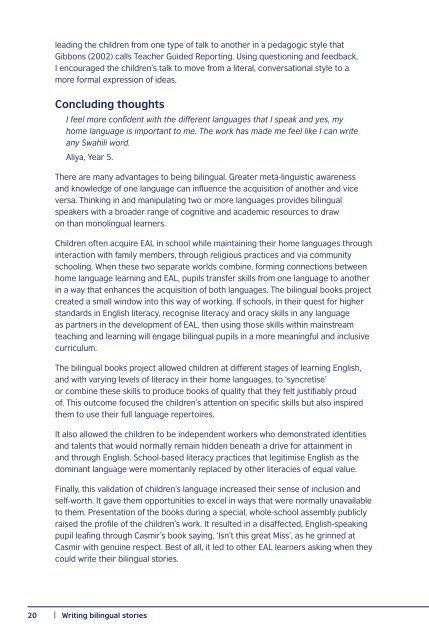Innovations in English language teaching for migrants and refugees
Innovations in English language teaching for migrants and refugees
Innovations in English language teaching for migrants and refugees
You also want an ePaper? Increase the reach of your titles
YUMPU automatically turns print PDFs into web optimized ePapers that Google loves.
lead<strong>in</strong>g the children from one type of talk to another <strong>in</strong> a pedagogic style that<br />
Gibbons (2002) calls Teacher Guided Report<strong>in</strong>g. Us<strong>in</strong>g question<strong>in</strong>g <strong>and</strong> feedback,<br />
I encouraged the children’s talk to move from a literal, conversational style to a<br />
more <strong>for</strong>mal expression of ideas.<br />
Conclud<strong>in</strong>g thoughts<br />
I feel more confident with the different <strong>language</strong>s that I speak <strong>and</strong> yes, my<br />
home <strong>language</strong> is important to me. The work has made me feel like I can write<br />
any Swahili word.<br />
Aliya, Year 5.<br />
There are many advantages to be<strong>in</strong>g bil<strong>in</strong>gual. Greater meta-l<strong>in</strong>guistic awareness<br />
<strong>and</strong> knowledge of one <strong>language</strong> can <strong>in</strong>fluence the acquisition of another <strong>and</strong> vice<br />
versa. Th<strong>in</strong>k<strong>in</strong>g <strong>in</strong> <strong>and</strong> manipulat<strong>in</strong>g two or more <strong>language</strong>s provides bil<strong>in</strong>gual<br />
speakers with a broader range of cognitive <strong>and</strong> academic resources to draw<br />
on than monol<strong>in</strong>gual learners.<br />
Children often acquire EAL <strong>in</strong> school while ma<strong>in</strong>ta<strong>in</strong><strong>in</strong>g their home <strong>language</strong>s through<br />
<strong>in</strong>teraction with family members, through religious practices <strong>and</strong> via community<br />
school<strong>in</strong>g. When these two separate worlds comb<strong>in</strong>e, <strong>for</strong>m<strong>in</strong>g connections between<br />
home <strong>language</strong> learn<strong>in</strong>g <strong>and</strong> EAL, pupils transfer skills from one <strong>language</strong> to another<br />
<strong>in</strong> a way that enhances the acquisition of both <strong>language</strong>s. The bil<strong>in</strong>gual books project<br />
created a small w<strong>in</strong>dow <strong>in</strong>to this way of work<strong>in</strong>g. If schools, <strong>in</strong> their quest <strong>for</strong> higher<br />
st<strong>and</strong>ards <strong>in</strong> <strong>English</strong> literacy, recognise literacy <strong>and</strong> oracy skills <strong>in</strong> any <strong>language</strong><br />
as partners <strong>in</strong> the development of EAL, then us<strong>in</strong>g those skills with<strong>in</strong> ma<strong>in</strong>stream<br />
teach<strong>in</strong>g <strong>and</strong> learn<strong>in</strong>g will engage bil<strong>in</strong>gual pupils <strong>in</strong> a more mean<strong>in</strong>gful <strong>and</strong> <strong>in</strong>clusive<br />
curriculum.<br />
The bil<strong>in</strong>gual books project allowed children at different stages of learn<strong>in</strong>g <strong>English</strong>,<br />
<strong>and</strong> with vary<strong>in</strong>g levels of literacy <strong>in</strong> their home <strong>language</strong>s, to ‘syncretise’<br />
or comb<strong>in</strong>e these skills to produce books of quality that they felt justifiably proud<br />
of. This outcome focused the children’s attention on specific skills but also <strong>in</strong>spired<br />
them to use their full <strong>language</strong> repertoires.<br />
It also allowed the children to be <strong>in</strong>dependent workers who demonstrated identities<br />
<strong>and</strong> talents that would normally rema<strong>in</strong> hidden beneath a drive <strong>for</strong> atta<strong>in</strong>ment <strong>in</strong><br />
<strong>and</strong> through <strong>English</strong>. School-based literacy practices that legitimise <strong>English</strong> as the<br />
dom<strong>in</strong>ant <strong>language</strong> were momentarily replaced by other literacies of equal value.<br />
F<strong>in</strong>ally, this validation of children’s <strong>language</strong> <strong>in</strong>creased their sense of <strong>in</strong>clusion <strong>and</strong><br />
self-worth. It gave them opportunities to excel <strong>in</strong> ways that were normally unavailable<br />
to them. Presentation of the books dur<strong>in</strong>g a special, whole-school assembly publicly<br />
raised the profile of the children’s work. It resulted <strong>in</strong> a disaffected, <strong>English</strong>-speak<strong>in</strong>g<br />
pupil leaf<strong>in</strong>g through Casmir’s book say<strong>in</strong>g, ‘Isn’t this great Miss’, as he gr<strong>in</strong>ned at<br />
Casmir with genu<strong>in</strong>e respect. Best of all, it led to other EAL learners ask<strong>in</strong>g when they<br />
could write their bil<strong>in</strong>gual stories.<br />
20 | Writ<strong>in</strong>g bil<strong>in</strong>gual stories


